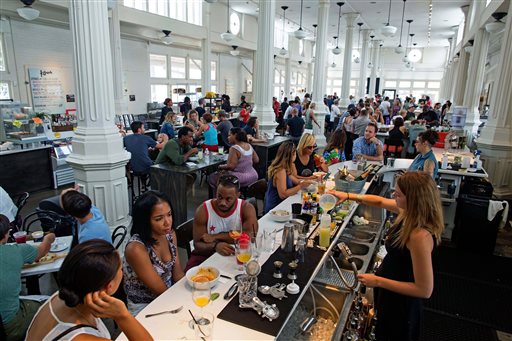
Crowds gather for Sunday brunch at the newly renovated St. Roch market in New Orleans, Sunday, Aug. 16, 2015. Helped by billions of dollars in recovery money, buoyed by volunteers and driven by the grit of its own citizens, New Orleans has rebounded in ways few thought possible in the ten years after Hurricane Katrina. AP PHOTO
NEW ORLEANS, United States–New Orleans will mark the 10th anniversary of Hurricane Katrina Saturday with solemn memorials and boisterous brass bands as the “Big Easy” remembers those lost to the devastating storm and celebrates its resilience.
“Come hell or high water — and we have had both — New Orleans is coming back,” Mayor Mitch Landrieu said at one of many memorials this week. “And we are coming back strong.”
More than 1,800 people were killed across the US Gulf Coast when Katrina struck on August 29, 2005. A million people were displaced and the financial toll topped $150 billion.
Landrieu and other dignitaries will mark the moment when the first levee was breached with a wreath-laying ceremony in the hard-hit Lower Ninth Ward at 8:29 am (1329 GMT).
Later in the morning a “Resilience Fest” will feature a New Orleans-style “second line” marching brass band.
Other neighborhoods and cultural centers are scheduled to hold their own parties and parades before former president Bill Clinton speaks at an evening commemoration, with performances by a number of Grammy-winning musicians.
The events commemorate the destruction of New Orleans — and the botched government response to the mounting crisis — which shocked the world.
This combination of Aug. 30, 2005 and July 29, 2015 aerial photos shows the Lower Ninth Ward of New Orleans flooded by Hurricane Katrina and the same area a decade later. Before Katrina, the Lower Ninth Ward was a working-class and predominantly African-American neighborhood just outside the city’s historic center. AP PHOTOS
Some 80 percent of the low-lying coastal city was swallowed by floods which rose as high as 20 feet (six meters) after the coastal city’s poorly-built levee system burst from the pressure of a massive storm surge.
The water came up so fast some people drowned in their homes. Hundreds more were stranded on their rooftops.
The few dry spots in the city descended into chaos as tens of thousands of increasingly desperate people with little food or clean water waited day upon day for help to finally reach them.
‘Sea of misery and ruin’
“All of us who are old enough to remember will never forget the images of our fellow Americans amid a sea of misery and ruin,” former president George W. Bush said in a visit to a New Orleans school Friday.
READ: George W. Bush visits disaster zone, 10 years after Katrina
Bush, who faced intense criticism for his handling of the crisis, said he was moved by the city’s determination to “rebuild better than before” and “a spirit much stronger than any storm.”
“We honor the resilience of a great American city whose levees gave out but whose people never gave up,” he added.
Colorful homes on stilts have replaced many of the rotten hulks left behind by the stagnant flood waters. Music and the smell of gumbo once again waft through the bustling streets of the French Quarter.
The tourism industry is booming with nine million visitors last year and the city has managed to attract a growing number of tech firms and new businesses.
Crime — while still high — is improving, with the murder rate hitting a 43-year low in 2014 and the population in city jails down by two-thirds.
The troubled school system was reformed, pushing graduation rates and test scores up sharply.
‘Extraordinary resilience’
President Barack Obama praised the “extraordinary resilience” of those who returned to New Orleans to repair shattered homes and businesses and “build a better future.”
READ: Obama lauds ‘inspirational’ New Orleans, decade after Katrina
Katrina “started out as a natural disaster became a manmade disaster — a failure of government to look out for its own citizens,” Obama said as he toured the city Thursday.
While he said much work remains to address the city’s poverty, violence and inequality, Obama said New Orleans has become a “model for the nation.”
Some residents say the flavor of a city that was once more Creole and Afro-Caribbean than American has been altered by the storm.
A huge swath of the population never came back. New Orleans now has 100,000 fewer residents than it did before Katrina and many are newcomers.
The black population has fallen by about 115,000 people, dropping from 68 percent of residents in 2000 to 60 percent in 2013, latest census figures show.
Plenty of white residents also found the emotional and financial cost of rebuilding to be too high, though their numbers are harder to measure.